What Is Complexity Science?
A Contextually Grounded Tapestry of Systemic Dynamism, Paradigm Diversity, Theoretical Eclecticism, and Organizational Learning
Ray W. Cooksey
University of New England, USA
Introduction
What is complexity science? This question invokes systemic and dynamic thinking at many levels, which means that arriving at a coherent answer will be a complex process in and of itself. I will argue in this article that a coherent answer to the question must, of necessity, draw on a diverse range of disciplines, while at the same time demanding a reconceptualization of those disciplines in the context of the new science we are describing. A coherent answer must also address the theoretical, methodological, and practical implications of the emergent science. Finally, a coherent answer must, itself, be contextually shaped and sensitized so that complexity science in the context of organizations and management will look, operate, and feel somewhat different to a complexity science for medicine or engineering.
The essential foundation of complexity science in organizational contexts is multidimensional diversity, consistent with the thesis developed by Flood and Romm (1996): diversity in thinking, theorizing and conceptualizing organizational and management problems and issues, diversity in methodologies and pathways for achieving understanding of those problems and issues, and diversity in predictive capabilities and solution discovery with respect to those problems and issues. I will argue that complexity science is best conceived as a process for weaving systemic dynamism, paradigmatic diversity, theoretical eclecticism, and individual/organizational learning into a contextually grounded tapestry. In this sense, I propose that complexity science assumes the status of a “meta-paradigm”: guiding instead of prescribing, adapting instead of formalizing, learning instead of defending, complexifying instead of simplifying, and including instead of excluding.
FOUR INTERLOCKING GENERAL PRINCIPLES IN THE TAPESTRY OF COMPLEXITY SCIENCE
The first stage in developing a coherent perspective on complexity science is to identify and flesh out four essential yet general and interdependent principles: systemic dynamism, paradigm diversity, theoretical eclecticism, and individual/organizational learning. These principles emerge from an integrated reading of a multiplicity of sources and, when dynamically woven together, constitute the essence of what I am calling the complexity science tapestry.
GENERAL PRINCIPLE #1: SYSTEMIC DYNAMISM
Complexity science, in organization and management contexts, embodies a nonlinear systems-oriented perspective that attempts to conceptualize, understand, and intervene in organizational systems at multiple levels (e.g., individuals, groups, organization, environment) in full recognition of the dynamic linkages and influences that operate within and between aspects of those system levels through time and space. Three key points of focus are dynamic change over time, the interplay and balance between negative system-stabilizing feedback and positive system-destabilizing feedback, and fundamental limits to the predictability of behavioral systems. Further, a focus on system dynamism means that we are constantly trying to understand and actively deal with the constraints and potentials that influence the systems we inhabit, rather than assuming that they are random, don't exist, or are simply something to be held constant.
SYSTEMS THEORY AND SYSTEMS THINKING
One key aspect of the principle of systemic dynamism is systems theory and its more recent evolution, systems thinking. General systems theory (see, for example, Capra, 1996; Checkland, 1981; Churchman, 1968, 1971; Flood & Carson, 1988; Harrington et al., 1999; Miller, 1973; Miller & Miller, 1993; Skyttner, 1997) reinforces the need for a more holistic contextual focus for the study of human behavior in organizations. This is particularly true of open systems that apply discontinuous transformational operations to environmental inputs and system resources in order to create new system processes and outputs. Open systems operate most effectively in contexts where adequate feedback regarding the quality of system resources, processes, and outputs is available and can be acted on. System functioning can therefore become adaptive (i.e., learning occurs and system behaviors change) if there is sufficient effort expended in the gathering of feedback and sufficient energy spent in responding to the demands of that feedback (Gates & Cooksey, 1998).
Systems theory further allows us to differentiate between positive and negative feedback, which can broadly be viewed as information flows that emerge as a consequence of the dynamic unfolding of system behavior through time. Negative feedback emerges when observed or perceived comparisons of current state(s) of the system to the desired state(s) of the system highlight discrepancies, which then stimulate correctional actions to close the “gaps.” Responses to negative feedback therefore pursue system equilibrium or stability by dampening the inherent variability in system behavior. Positive feedback emerges from a realization that the current state(s), assumptions, or worldviews held within the system may in fact not be correct, and seeks to create a discontinuous shift in system orientation toward new forms of behavior, new sets of assumptions, and new worldviews. Positive feedback thus creates disequilibrium or instability by encouraging variability in pursuit of new ways of achieving goals or of new assumptions, goals, and perspectives themselves.
In complexity science anchored by general systems principles, there are limits to the extent to which reductionism will yield positive and productive gains in understanding. This is because a detailed understanding of the individual components of a system provides little or no information about the multiplicity of linkages and feedback loops that may exist between the various components. Maintaining a holistic perspective and contextual sensitivity is an effective way to keep tabs on the diversity of causes and effects that permeate the system; a point reinforced by Tweney in his discussions of scientific reasoning (Tweney, 1994; Tweney & Chitwood, 1995). This same diversity (what Brunswik, 1952, and Emery & Trist, 1965, referred to as “causal texture”) is what makes it so difficult for individual/social/organizational systems to achieve long-term relatively stable levels of functioning. The more complex the system, the more opportunity there is for the multiplicity of positive and negative feedback loops to create unpredictable behavioral outcomes. However, Morin (1992) cautioned that it was equally dangerous for systems theory to reify holism as it was for the behavioral sciences to reify reductionism. He advocated a process very similar to double-loop learning to maintain an appropriate balance and tension between holism and reductionism, in such a way as to permit the emergence of a unique conception of “system” as not only a general descriptive concept but a generative concept, able to energize new and different ways of thinking and meaning.
Systems thinking (see, for example, Anderson & Johnson, 1997; Flood, 1999; Senge, 1990; Senge et al., 1994) is a more recent evolution of systems theory and focuses on methods, procedures, and perspectives for enhancing human opportunities to engage in systemic theorizing and problem solving. Systems thinking has become intimately intertwined with the concept of organizational learning, and is designed to help people externalize their mental models for the world (including unpacking perceived cause-effect linkages and feedback loops) and contextualize, implement, and evaluate those models when put into practice. Complexity science captures the spirit of systems thinking through its consistent and coherent focus on systemic dynamism. Further, the complexity science tapestry amplifies and facilitates important systems thinking opportunities through its interconnectedness with both the paradigm diversity principle and the theoretical eclecticism principle.
NONLINEAR SYSTEM DYNAMICS AND THE IMPORTANCE OF CONTEXT
A second key aspect of the principle of systemic dynamism is nonlinear systems dynamics. This has emerged as a way of conceptualizing complexity in behavioral systems that exhibit strong tendencies toward nonequilibrium. (See, for example, Abraham & Gilgen, 1995; Ayer, 1997; Barton, 1994; Guastello, 1995; Levine & Fitzgerald, 1992; Loye & Eisler, 1987; Parker & Stacey, 1995; Priesmeyer, 1992; Robertson & Combs, 1995. Historically, nonlinear dynamic systems and open systems are not new concepts, as early work by such writers as Bertalanffy, 1955, 1968; Brunswik, 1952; Mary Parker Follett—see the recent review by Mendenhall et al., 2000; Levin, 1951; and Miller, 1973 revealed.)
Nonlinear dynamic systems are characterized by contextual sensitivity to initial conditions (Priesmeyer, 1992), problems in long-term system predictability (Gregersen & Sailor, 1993; Loye, 1995), bounded instability (Parker & Stacey, 1995), and periodic excursions into chaotic behavior (Guastello, 1995). Nonlinear systems are also characterized by the existence of one or more “attractors” that act as focal points for system behavior. Such attractors become “strange” if behavior is continually drawn toward them, but never through the exact same pathways and never to the point where a long-term equilibrium state is achieved. This chaotic state of behavior is often stimulated if the amount of negative dampening feedback in the system is exceeded by the amount of positive destabilizing feedback (Briggs & Peat, 1999). The result is fundamentally unpredictable behavior sensitized to a specific array of contextual features and issues. Loye (1995) and Briggs and Peat (1999) argued that the creative harnessing of positive system feedback could lead the system through a chaotic phase to achieve a new more stable behavioral pattern. Systems that can achieve this goal are termed “self-organizing” or “emergent systems,” and they represent contexts where simpler behavioral states evolve out of complex system dynamics (Barton, 1994; Capra, 1996; Cohen & Stewart, 1994; Kaplan & Kaplan, 1991).
The most important expectation one can have of a nonlinear dynamic system is that it will be in a relatively constant state of change and flux in response to a myriad of constraining and amplifying contextual factors. Because dynamic systems are generally nonlinear, there are no simple pathways through them to some end state or outcome. Changes in input at one point in the system, even if minute, may cause huge changes in system output—a pattern characteristic of sensitivity to initial conditions. System dynamics may be rendered even more complex if the character of information on which the system acts is considered to be “fuzzy” rather than categorically precise (Kosko, 1993).
The necessity of appropriately contextualizing behavioral systems and their nonlinear dynamics cannot be overemphasized. Complexity science must not only take on board the important concepts that arise from a general systems/systems thinking perspective, but must also marry those concepts with an understanding that human systems are nonlinearly dynamic, and that the tension in emphasis on negative and positive feedback may occasionally tip complex human systems into a chaotic state as a prelude to new emergent system states exhibiting more stable behaviors. Stability in complexity science will always be a matter of more/less (which, incidentally, redefines “stability” as a “fuzzy” construct instead of a finite state), rather than either/or.
GENERAL PRINCIPLE #2: PARADIGM DIVERSITY
Complexity science embraces paradigm diversity by attaching value to what can be learned about system behavior from within any particular paradigm perspective, be it positivistic, interpretive/phenomenological, critical social science, or some other. Thus, complexity science adopts the mindset that multiple worldviews are, in fact, acceptable, and what must be done is to decide how to contexualize each worldview into the larger scheme of things (thus creating a need to change our processes for judging the quality of knowledge generation with respect to complex systems). Flood and Romm (1996) have argued that, in developing their concept of triple-loop learning, the management of paradigm diversity becomes a type of learning process where one is able to ask and sensibly answer questions about which paradigm approach (with all of its accompanying assumptions and theoretical and methodological associations) is most appropriate for a specific context and problem. Embracing paradigm diversity means that different ways of conceptualizing problems and pathways toward solutions remain open questions for us to explore— the old problem of forcing a problem to fit a paradigm can at last be rectified so that paradigms are chosen to best fit the problem at hand. Triangulation emerges as a more routine practice.
TRANSCENDING PARADIGM BOUNDARIES
Mainstream behavioral science, in many of its current forms as well as in many extant curricula for training undergraduate and postgraduate students in the psychological, sociological, and management disciplines, is marked by the strong dominance of what philosophers as well as behavioral and social scientists have termed the “positivistic research tradition” (Bernstein, 1978; Crotty, 1998; Guba & Lincoln, 1998; Neuman, 2000). The positivistic tradition is associated with values and processes such as a priori theorizing and hypothetico-deductive reasoning, Popperian falsificationism, behavioral determinism, researcher “objectivism” and value neutrality, empirical observation, measurement and quantification, reliance on highly quantified linear statistical models, control through deliberate contextual intervention so as unambiguously to isolate cause and effect relationships, and the pursuit of generalizable laws of behavior.
However, several other human/social science traditions have more recently emerged, each claiming to provide routes to understanding human behavior in organizational and other contexts (see, for example, the recent discussions in Crotty, 1998, Flood & Romm, 1996, and Guba & Lincoln, 1998; Bernstein, 1978, and Burrell & Morgan, 1979, also provide excellent reviews). For example, the “interpretive” or phenomenological tradition, broadly defined, seeks to understand problems and issues from the perspective of the people who are confronting them. Reality and meaning are socially negotiated and constructed from the interpretivist perspective: a deliberately inductive and subjectivist/constructivist yet value-neutral orientation. Language looms large as the central source of data for the interpretive researcher, producing a strong preference for qualitative methodologies. The interpretive researcher seeks to build up an account for specific contextual realities through concrete interactions with, and observations of, people of interest—empirical observation thus guides the emergence of theory.
Other more recently evolved traditions for inquiry, such as critical theory (as developed by such philosophers as Hegel, Marx, and Habermas— a good integrative summary appears in Bernstein, 1978; see also Magala, 2000), critical psychology and social theory (e.g., Fox & Prilleltensky, 1997), feminist critique (e.g., Wilkinson, 1997), and “action” research (e.g., Guba & Lincoln, 1989), while typically sharing strong interpretivist leanings, have adopted a more critical stance where a specific value position is deliberately invoked to guide inquiry, understanding, and problem solving (signaled through the use of such language as “power,” “oppression,” “social justice,” “action learning,” “improvement,” and “emancipation”). It can also be argued that approaches to complexity are themselves reflecting the emergence of a new behavioral science tradition (to which this issue of Emergence is designed to put some shape). The emergence of a “complexity paradigm” is evident across a range of recent contributions to various multidisciplinary journals that attempt to explore the implications of complexity perspectives in organizational and management contexts (see, for example, Cooksey, 2000; Cooksey & Gates, 1995; Dijkum, 1997; Lissack, 1997, 1999; Maguire & McKelvey, 1999; Magala, 2000; McKelvey, 1999; McKelvey et al., 1999; Mendenhall et al., 2000; Tetenbaum, 1998).
Each behavioral science tradition can be seen to constitute a “paradigm” in the view of Kuhn (1970), a systemic program that evolves over time to guide “scientific” inquiry behaviors in specific domains. The difficulties created by paradigm-driven behaviors are that they tend to generate boundaries that are largely impenetrable to other perspectives and robust against contradictory evidence. Thus, inquiry and understanding as well as problem-solving pathways achieved within one tradition or paradigm are frequently ignored or actively denigrated by workers operating in other paradigms.
However, it seems clear that this trend is slowly breaking down with the increasing advent of cross-disciplinary and multidisciplinary journals, increasing reliance on triangulated methods in inquiry, and more focused arguments about the virtues of methodological pluralism. Sharlett (2000), writing about the philosopher Steve Fuller (see also Fuller, 1988), provides some compelling arguments for moving beyond the strictures of Kuhn's worldview. Yolles (1998), Flood and Romm (1996), Smith (1975) and others have argued, from various points of view, for methodological complementarism, rather than competition, in the organization and management “sciences.” Churchman (1971; later reviewed and updated by Müller-Merbach, 1994) developed a typology of five inquiring systems (Leibnizian, Hegelian, Kantian, Lockean, and Singerian), each focusing on a different way of designing an epistemological system. Churchman's main conclusion regarding the design of inquiring systems—and, by extension, the design of any system—was that no single system design could be uniformly recommended; design was dependent on the demands of the environment within which the system was embedded.
This conclusion reinforces the importance of methodological diversity in the study of human behavioral systems under different conditions and constraints. Further, it has the potential to lead inquiry further down the path toward deliberate method triangulation to provide a deeper, more productive, and convincing understanding of human behavior. Thus, Kuhn's (1970) arguments regarding the apparent incommensurability of different paradigms can be circumvented by adopting a more systemic and complex perspective toward understanding human behavior and encouraging, wherever possible, triangulated methodological tactics and strategies. It was to this point that Flood and Romm (1996) addressed the emergence of triple-loop learning as a “meta-strategy” for deciding on methodological (as well as theoretical and model-based) appropriateness.
GENERAL PRINCIPLE #3: THEORETICAL ECLECTICISM
If complexity science reinforces the value of multiple paradigms, it must then also reinforce the value of multiple theoretical stances. This means that there may be many pathways toward explanation of a specific organizational or management issue. The trick is to know and decide what one gains and what one loses when traveling down the different pathways. Different paradigm choices imply different conceptions of theory (e.g., grounded or emergent theory, action theory, nomological networks, implicit theory, critical theory) and this diversity must be acknowledged.
Theoretical diversity also implies shifting perspectives on the role, value, and accuracy of prediction and forecasting in organizational affairs, and on the importance of and balance between objectivist and subjectivist viewpoints.
ACCEPTING THEORETICAL “PLURALISM”
Flood and Romm (1996), among others, have argued that diversity in the theories and models used to understand and represent behavior in complex systems is a natural evolution for system inquiry. Such theoretical “pluralism” holds great promise within complexity science, because it inoculates inquiry against premature and uncritical closure on a specific point of view or explanation (such closure being one main reason that management “fads” have become so easy to spawn and spread; see discussions by Abrahamson, 1996, Dreilinger, 1994, Shapiro, 1995, and Spell, 1999; see also the management “lexicon” presented in Cooksey et al., 1998). There is a close synergy between theoretical pluralism and paradigm diversity—each general principle implies the other.
In complexity science, it will be essential for inquirers to learn how to make intelligent, convincing, and constructive criticism of theories and models using criteria appropriate to the paradigm that gave rise to them. The biggest danger, and one that is continually replayed even today, is for the theories and models established within one paradigm to be assessed against criteria from a different paradigm—inevitably but unjustly leaving the theory or model in question stripped of its power to convince (see, for example, Beer, 1993, for a discussion of one facet of this problem centering on the political nature of the concept of “validity”). One implication of Flood and Romm's (1996) concept of triple-loop learning is acquiring sensitivity to and facility with choosing the correct criteria for judging the convincingness of any theory or model. Harnessing this sensitivity and skill, therefore, is a critical aspect of complexity science.
GENERAL PRINCIPLE #4: INDIVIDUAL AND ORGANIZATIONAL LEARNING
Complexity science embodies not only diversity in conceptualizations, paradigms, methodologies, and understandings, but also the conceptual “hardware” and “software” necessary for conducting its own selfreflection for learning. The pathway to individual and organizational learning is opened when, through the interplay of systemic dynamism, paradigm diversity, and theoretical eclecticism, we reflect on and devise
new ways for translating what we learn into what we do and what we do into what we learn. This is in part what people like Senge, Argyris, Flood, and many others are after in their explorations of systems thinking, single-, double-, and triple-loop learning, and actionable knowledge. Complexity science invokes new ways of thinking that do not prematurely lock us on to a specific simplified pathway for solutions and understandings. It has the potential to counteract the rampant “faddism” that currently characterizes much of the organizational and management landscape, as long as it does not adopt the status and posture of a fad itself (the risk of this happening and paths to avoidance are coherently discussed by Maguire & McKelvey, 1999; and McKelvey, 1999). Ultimately, this translates to a complexity science whose scholars, researchers, and practitioners actively learn as they go, are self-reflective, and deliberately and continually engage themselves, not only in single-loop learning processes (closing the gaps in learning, typically based on inspection of outcomes and emphasizing doing better what they are already doing), but also in double-loop learning processes (questioning assumptions, goals, methods, and outcomes, and emphasizing a critical analysis of whether or not they are doing the appropriate or most relevant things) and triple-loop learning processes (making intelligent and defensible paradigm choices).
COMPLEXITY FEEDS LEARNING; LEARNING FEEDS COMPLEXITY
Gates and Cooksey (1998) and Cooksey (2000) argue that the concepts of negative and positive system feedback are closely related to Argyris's (1990, 1999) concepts of single-loop learning (emphasis on negative feedback) and double-loop learning (emphasis on both positive and negative feedback). We see, then, that a complexity science incorporating these ideas will tend to generate perspectives that can simultaneously emphasize both functioning and learning. Further, since negative and positive feedback generate a continual tension in focus, a perpetually important question that complexity science must address is: What is the most appropriate balance in focus in the light of the contextual constraints and opportunities confronting the system?
A critical lesson here is that systemic inquiry should complexify the problem before simplifying it, so that any simplification occurs in full knowledge of and conscious choices about what one is giving up and what one is gaining. Harnessing paradigm diversity and theoretical eclecticism will help in this regard, since the most immediate danger for any systemic inquiry is to let paradigm preferences and favorite theories and models determine what is factored in and what is factored out of the inquiry—a process made almost insidious by its frequent automaticity (strongly reinforced by the training background of the inquirer, coupled with pragmatic pressures of achieving career and other goal-related milestones).
A CONTEXTUALLY GROUNDED COMPLEXITY SCIENCE TAPESTRY FOR ORGANIZATIONS
I want now to develop a concrete representation of the complexity science tapestry, contextually grounded for organizations and management. In this representation, the interleaving of the four general principles through a complex network of interactions between contextual spheres of influence will emerge, and there will be clear signposts for how I would envisage inquiry progressing under the guidance of complexity science.
CONTEXTUAL SPHERES OF DYNAMIC INFLUENCE FOR ORGANIZATIONAL MEMBERS
A central aspect of the complexity science tapestry proposed here is the identification, expansion, and clarification of contextual “spheres” of dynamic influence on the life space and behavior of any organizational member. This can only be achieved by harnessing the potential synergies to be realized through valuing multiple perspectives and approaches (see recent arguments by Maruyama, 1992; Somit, 1992; and Wicklund, 1999). In a sense, our goal is the attainment of disciplinary unity through diversity. By creatively integrating what can be learned from philosophies of behavioral science, general systems theory, and nonlinear dynamics with contextualized knowledge of the human condition accumulated across many different disciplines and subdisciplines (e.g., the many subdisciplines of psychology, neuroscience and physiology, biology, evolutionary theory, anthropology, sociology, political science, ergonomics, ethics and other philosophies, economics, and archeology), five distinct contextual spheres of dynamic influence can be identified as potentially affecting any behavior of interest for any particular organizational member. The five contextual spheres are environmental, organizational, interpersonal, intrapersonal, and focal behaviors.
Figure 1 displays the possible dynamic interplay, at a macro level, among and between these five contextual spheres. All of the contextual spheres are interconnected, signaling that each can both influence, and be influenced by, each of the others. One essential lesson in Figure 1 is that there is no single linear pathway to behavioral understanding: numerous potential starting and ending points exist, linked through a potential myriad of direct, indirect, recursive, and nonrecursive linkages.
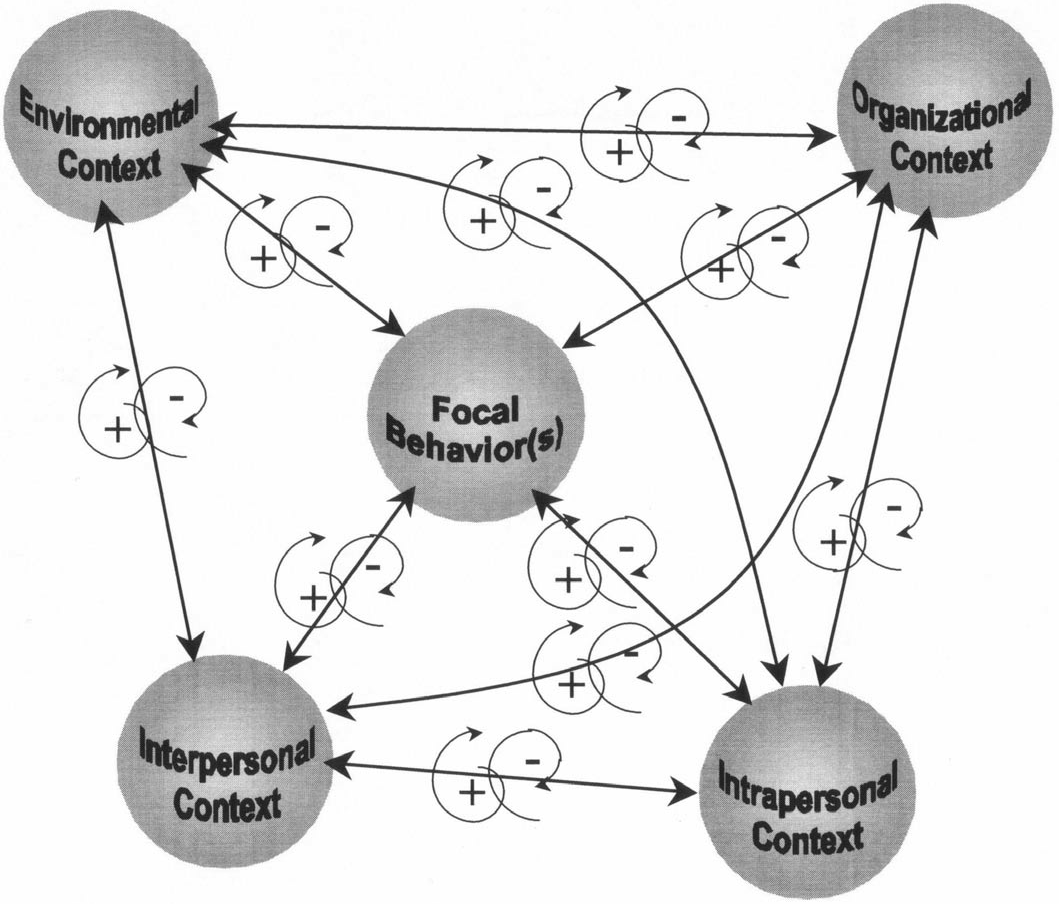
Figure 1. Macro system dynamics of organizational member contexts (showing illustrative cross-contextual influences and dynamic positive— destabilizing—and negative—stabilizing—cross-contextual feedback loops)
Each of the contextual spheres can be further unpacked into more specific and situationally relevant contextual features. Thus, the contextual spheres can be successively exploded from the highly macro-level perspective depicted in Figure 1 to a much more micro-level perspective where very specific contextual features have been identified, as shown in Figure 2. It is important to note that the specific contextual features highlighted for each sphere in Figure 2 are somewhat generic. In concrete application, each sphere would need its relevant features unpacked within the context of more specific focal behaviors. For example, Cooksey (2000) showed how the various contextual spheres would be exploded from macro to micro levels in the context of specific managerial decision-making behaviors. Additionally, specific aspects of one or more features of certain contextual spheres may constitute the focal behaviors under investigation, which means that they become part of the focal behaviors' context. The specific features and complexities within the organizational contextual sphere will vary according to the specific focal behaviors of interest.
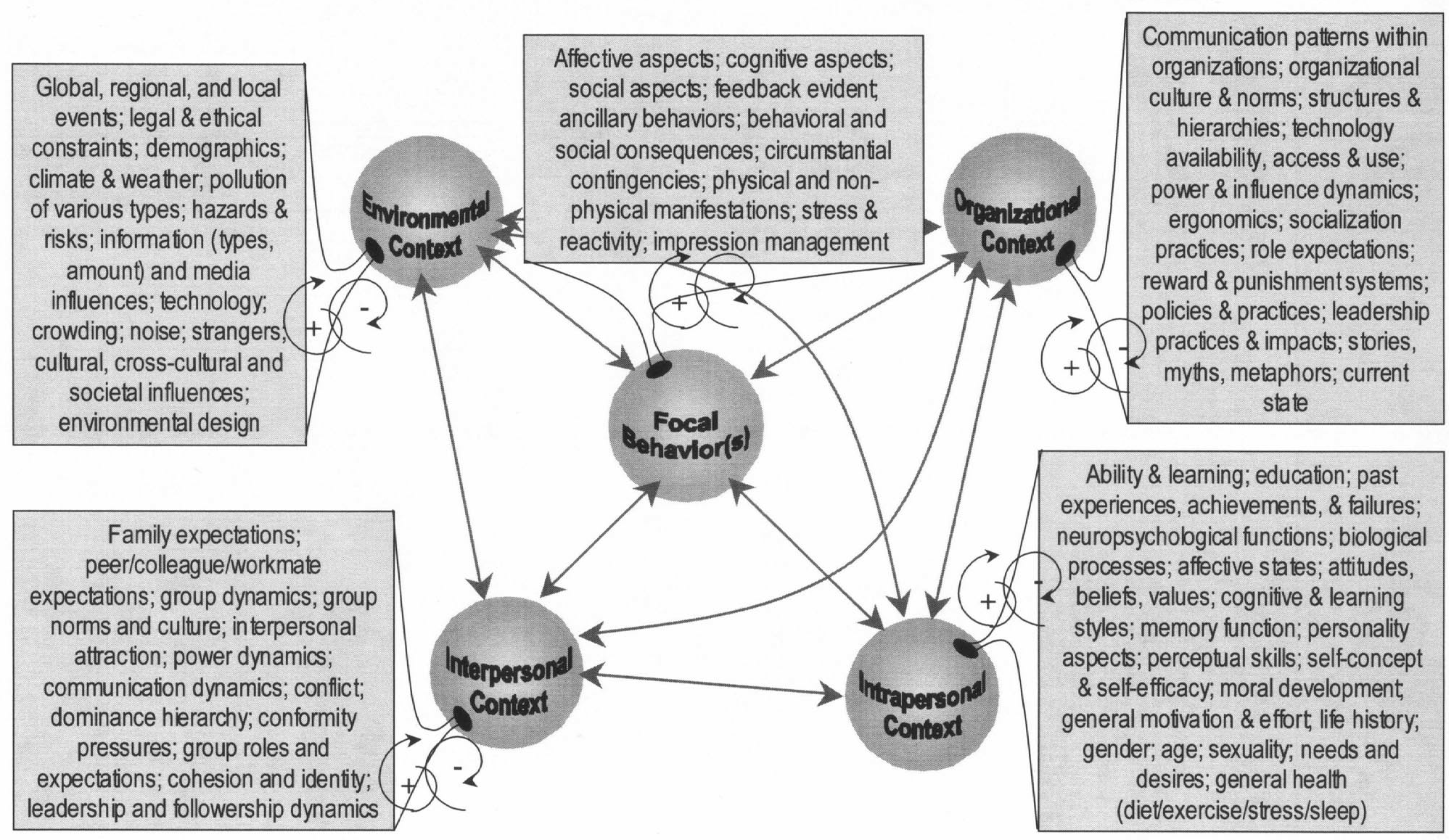
Figure 2. Micro system dynamics of organizational member contexts (showing subarrays of potentially interesting dynamic influences)
Figure 1 also incorporates explicit recognition that a complex tapestry of interlaced negative and positive dynamic feedback loops may be operating between any two contextual spheres. The relative balance between cross-contextual feedback types and sources will be very sensitive to the specific contextual features that are most potent at any one point in time under particular circumstances. A predominance of negative feedback between any two contextual spheres will have a stabilizing effect (behavioral variability will be reduced), whereas a predominance of positive feedback between any two contextual spheres will have a destabilizing effect (amplifying behavioral variability). Thus, throughout the map of contextual spheres, there is a complex array of both stabilizing and destabilizing influences on behavior, all of which serve to reduce the overall predictability of the system and which, under certain conditions, may sit on the “edge of chaos,” perhaps even slipping periodically into chaotic behavior (Waldrop, 1992; Cohen & Stewart, 1994; Briggs & Peat, 1999; Capra, 1996). The micro perspective depicted in Figure 2 shows that this dynamic interplay between positive and negative feedback can and will operate between various specific features within contextual spheres.
A further dimension can be added to the organizational members' network of contextual spheres when it is mapped on to a timeline. Figure 3 displays the evolutionary dynamics that may emerge through time, resulting in changes in mixtures and potencies of contextual features, overall contextual importance, and behavioral direction and focus. By its very nature, feedback, whether positive or negative, has a built-in temporal dimension that cannot be ignored. In Figure 3, then, we have a continual reminder that whatever we learn about behavior at one point in time could potentially be quite different at another point in time, because of the unique confluence of contextual influences operating between the various spheres.
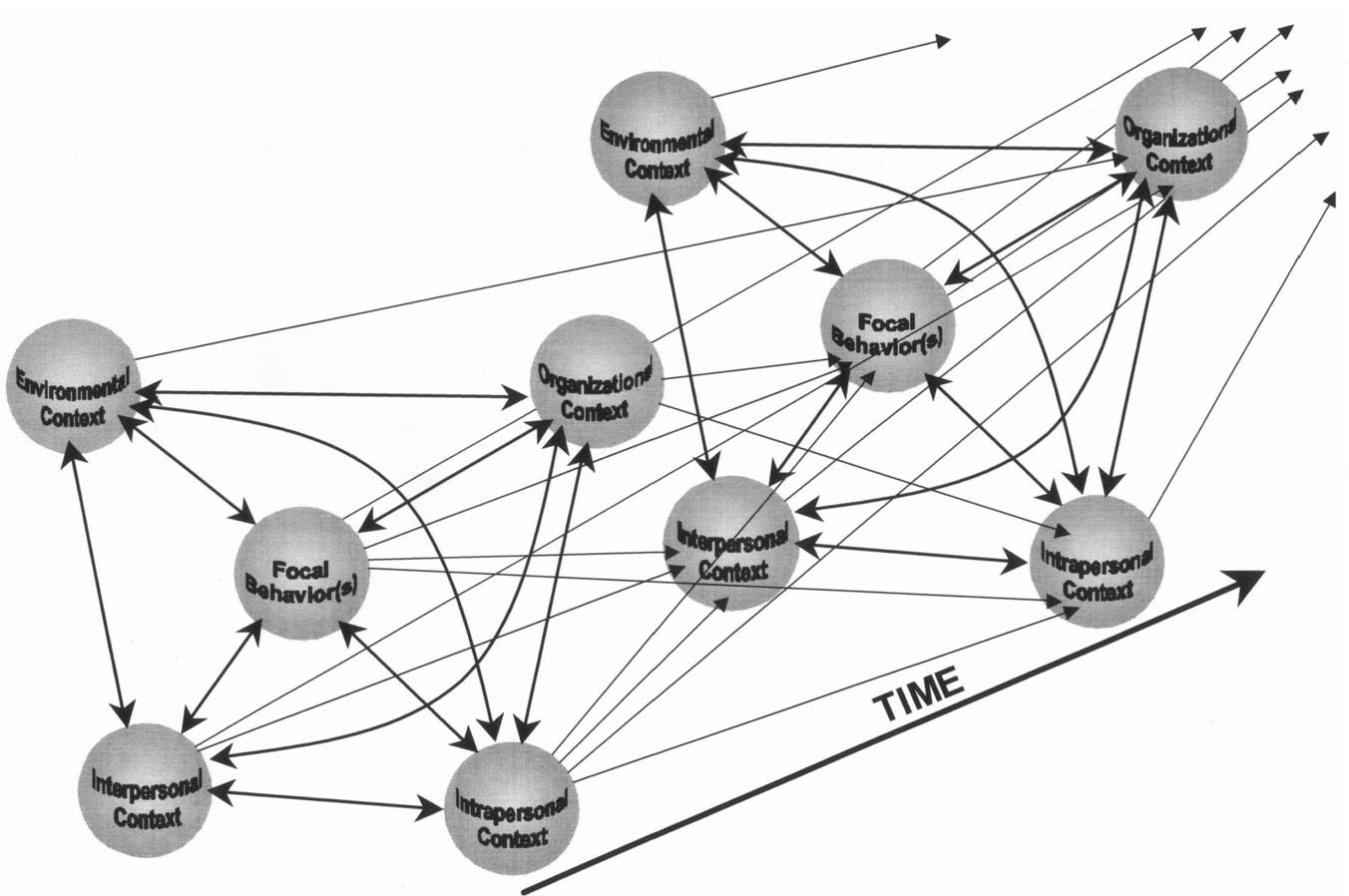
Figure 3. Temporal dimension of evolutionary dynamics of member contexts (showing illustrative temporal cross-contextual influences)
CONTEXTUAL SPHERES OF DYNAMIC INFLUENCE ON THE SYSTEMS INQUIRER
Thus far the tapestry has only focused on organizational members. From the point of view of complexity science, however, this is only part of the story. There is a second layer of contextual spheres that centers around the person or persons who seek to make inquiries into a particular organizational system (called the “inquiry” context, for short). Three contextual spheres can be identified: inquirer, inquiry, and inquiry tasks. For purposes of fleshing out the most robust form of complexity science, the broadest possible interpretation of “inquirer” in context is adopted, and should be read as encompassing people who formally conduct research investigations (university academics, consultants, and staff in research organizations), and other behavioral science practitioners who, by virtue of their roles, must amass, interpret, and apply information to the solving of specific problems, and organizational members themselves when engaged in action learning-type activities requiring information collection, reflection, and application. A similarly broad view is taken in the inquiry and inquiry task contexts.
This second layer of contextual spheres is depicted in Figure 4 and highlights the dynamic interconnectedness between the inquirer's individual context, the context of inquiry that they influence (and are influenced by), and the task context that evolves around the inquiry to facilitate collection of specific types of behavioral information. As with the contextual spheres for organizational members, the macro perspective of the inquirer contextual spheres can be exploded into a micro perspective depicting a myriad of more specific factors and influences, as shown in Figure 5. As with the organizational member contextual spheres, each of the inquirer spheres interacts dynamically through a complexly interwoven network of positive and negative feedback loops. Thus, when positive feedback loops dominate the relationships between inquirer, inquiry, and/or inquiry task contextual spheres, it is entirely possible for an inquirer to experience events (in the inquiry or inquiry task contexts) on the edge of chaos where expected events break down and the unpredictable happens (e.g., permission is withdrawn for research at a specific organization; a specific question on a survey stimulates unexpected unpleasant memories for particular organizational members; or the inquirer has to cease their investigation because a contracting organization wants access to all names of organizational members who had been promised anonymity).
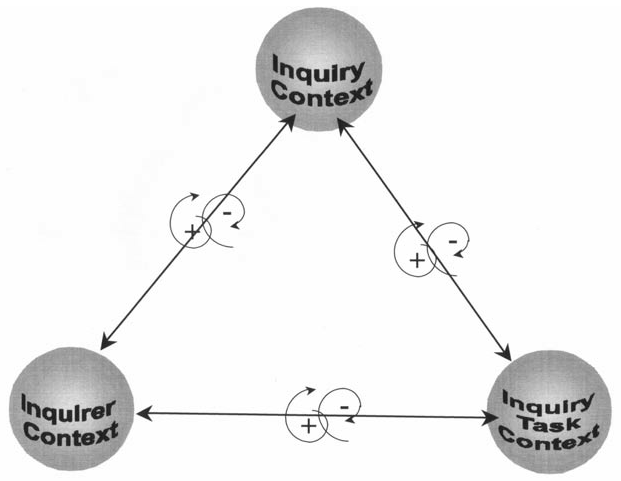
Figure 4. Macro-system dynamics of inquiry contexts (showing illustrative cross-contextual influences and dynamic positive—destabilizing—and negative—stabilizing—cross-contextual feedback loops)
CONFLUENCE OF ORGANIZATIONAL MEMBER AND INQUIRER CONTEXTUAL SPHERES
The complexity science tapestry emerges in full when the inquirer contextual spheres engage with organizational members' contextual spheres. Engagement can be seen to occur in one of three “planes” of contextual embeddedness that vary according to depth and breadth of cross-contextual interaction. The three planes of contextual embeddedness are displayed in Figure 6. The plane of abstraction is where engagement with the organizational member contextual spheres occurs in narrow, often highly controlled and contrived, circumstances dominated by maximal connectedness with the inquirer's contextual spheres (most likely in laboratory investigations). The plane of abstract experience is where engagement between the organizational members' contextual spheres and the inquirer's contextual spheres involves moving toward some middle ground incorporating some narrowness in focus and control/contrivance, but, at the same time, attempting to maintain a balanced connectedness with the behaving human's contextual spheres in some meaningful way
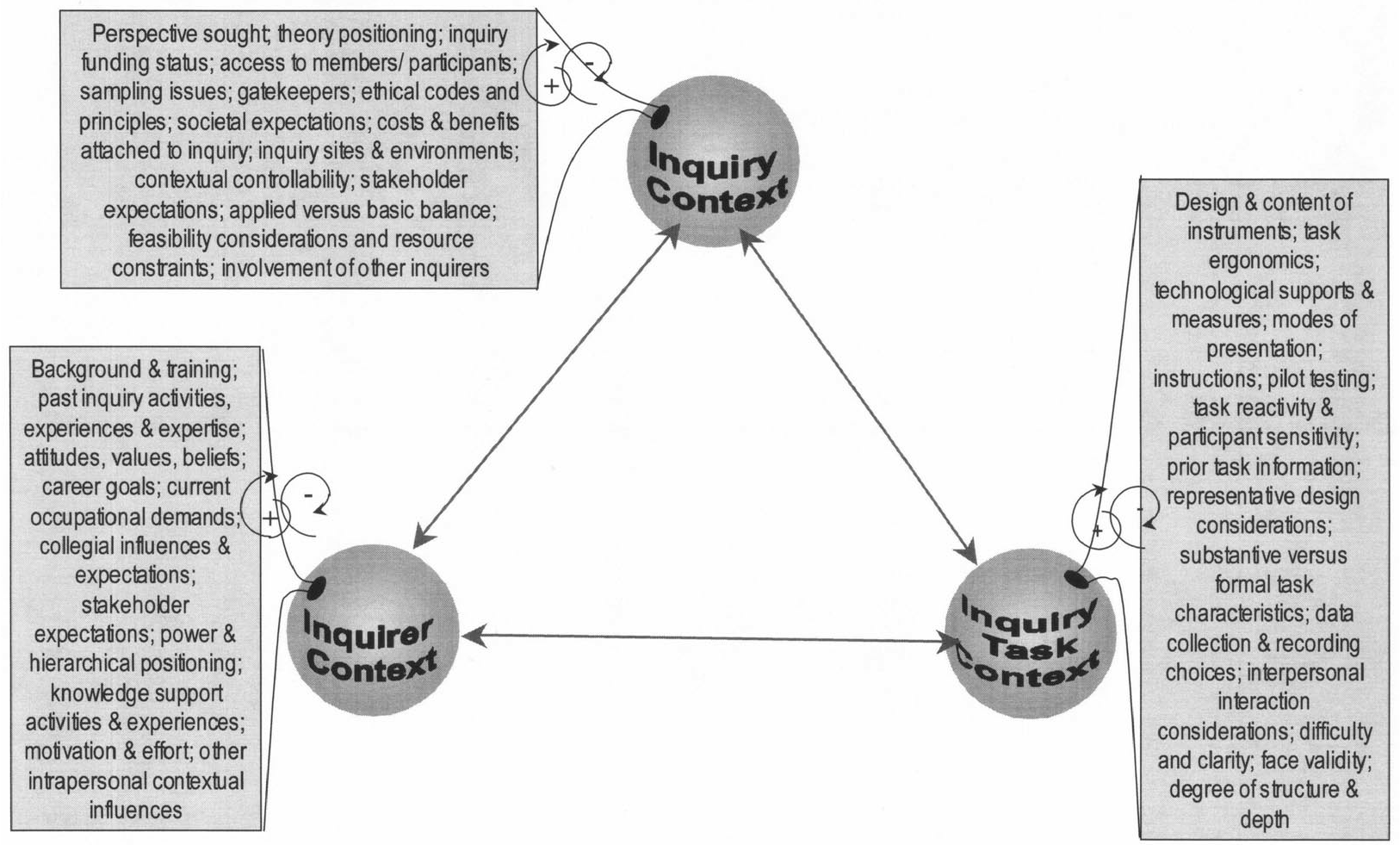
Figure 5. Micro-system dynamics of inquiry contexts (showing subarrays of potentially interacting dynamic influences)
(more likely in field experiments or surveys, or in interactions between a external change management consultant and members of an organization undergoing change). The plane of experience is where engagement between the organizational members' contextual spheres and the inquirer's contextual spheres is dominated by an interest in maintaining a high degree of fidelity and maximal connectedness with the organizational members' contextual spheres (as might occur in some forms of
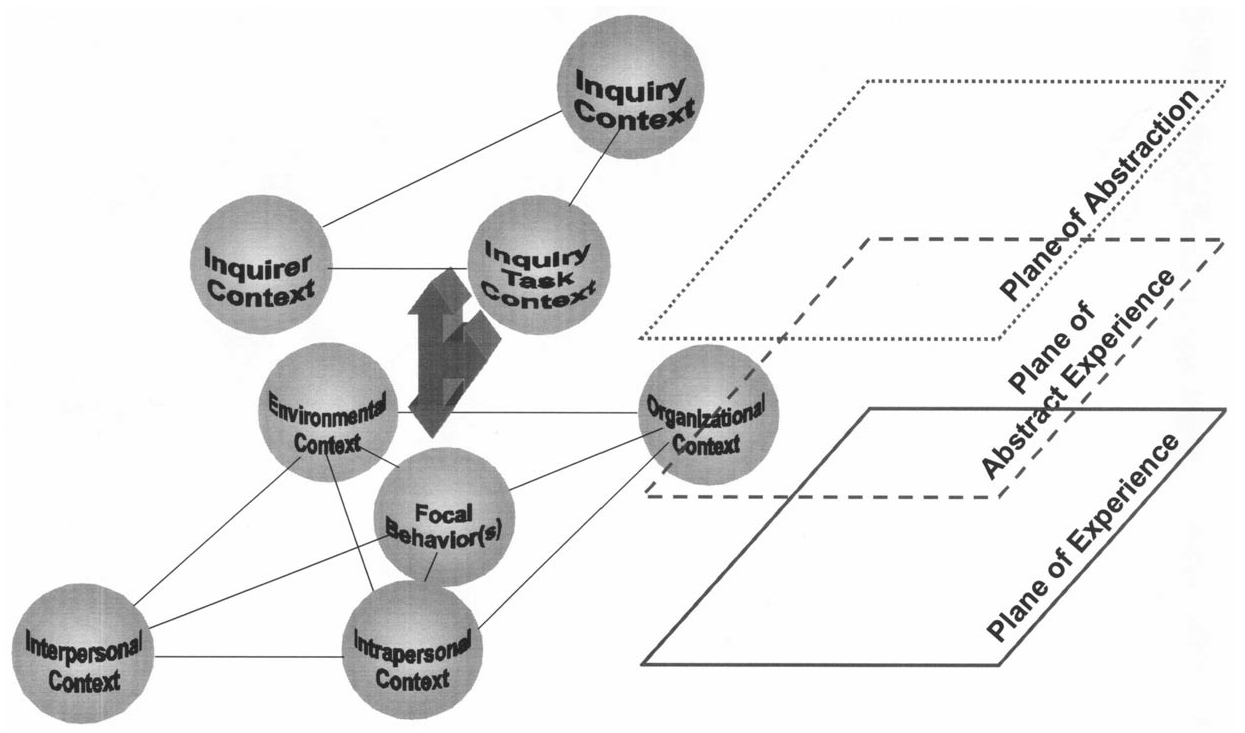
Figure 6. Contextual spheres of dynamic influence intersect three planes of contextual embeddedness in organizational complexity science
action research, phenomenographic research, or in change management being driven by an internal change agent).
The usefulness of identifying the three planes of contextual embeddedness is that they reveal how various paradigm choices might determine different mixtures and balances in interactions between various contextual spheres, without imposing an a priori judgment as to validity, suitability, or “rightness.” These mixtures will also influence the shape and status that various types of theories and models will assume. Figure 7 provides a series of illustrations of different planar mixtures invoked by different types of inquiry tasks. Contextual spheres in each diagram are shaded where the engagement involves partial contextual access in specific spheres or partial contextual sphere involvement. Connectedness between the inquirer's and organizational members' contextual spheres is depicted by embracing curved lines. Contextual spheres that remain unconnected would be virtually ignored by paradigm choices within the inquiry task being displayed.
For example, traditional experimental research is dominated by the inquirer's contextual spheres situated firmly within the plane of abstraction (the research being conducted in a highly controlled laboratory setting using artificially constructed tasks) and engaging only a subset of the organizational members' contextual spheres in the plane of abstract experience. Thus, such engagement involves minimal connectedness with genuine organizational members' contextual spheres except for specific focal behaviors (and, possibly, their linkages to some aspects of the organizational members' intrapersonal context: what they walk into the laboratory with as idiosyncratic “baggage”). From the organizational members' point of view, however, a more extreme case emerges when the “organizational members” for the research are, at best, loose approximations of actual organizational members, as is the case where undergraduate or MBA students are used for management research experiments and the inquiry may be entirely engaged in the plane of abstraction.
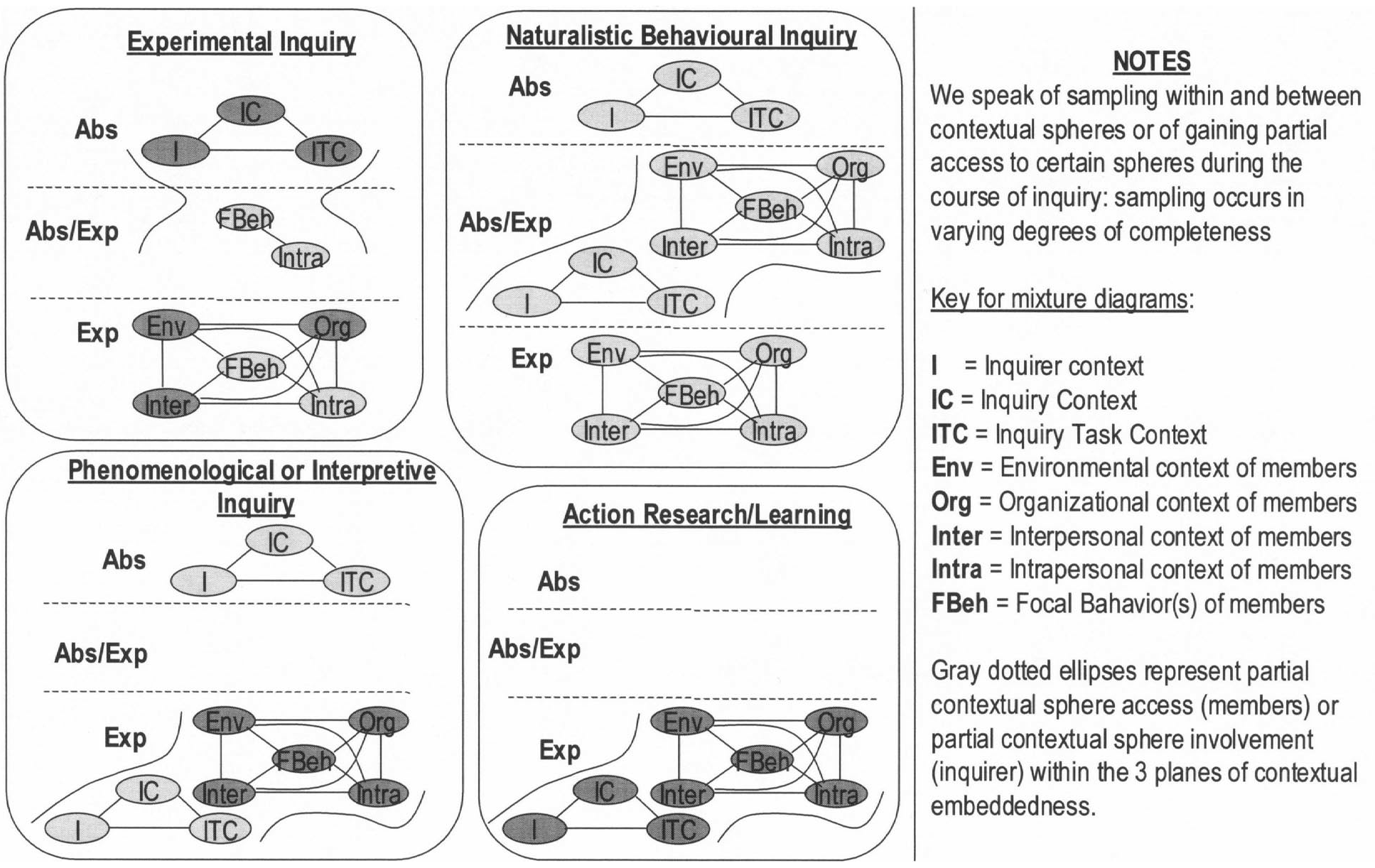
Figure 7. Illustrative methodological mixtures in organizational complexity science
In the positivistic paradigm, the inquirer's perspective is imposed on organizational members' contextual spheres in a highly structured, often contrived and controlled, manner in order to facilitate clear isolation of cause and effect in tests of hypotheses deduced from a specific theory. In contrast, research that occurs within the phenomenological or interpretive paradigm involves a partial immersion of the inquirer's contextual spheres in the organizational members' plane of experience. Here, the inquirer's perspective gives way to the organizational members' perspective and an in-depth understanding, description, and interpretation of the organizational members' perspectives is what is sought. However, this immersion must be considered partial, because even in the conduct of a full ethnographic study, the inquirer would retain some contact with their own contextual spheres, even though these may be deliberately “bracketed” from influencing interpretations as far as possible (unless the inquirer has “gone native” and lost their “research attitude”).
Thus, the complexity science tapestry as depicted here is intended to provide an integrative “meta-paradigm” for the organizational context—a conceptualization that captures the complex contextual dynamics in human behavior, in inquirer behavior, and in the intersection of the two. The multitude of differing paradigms available to inquirers can then be put into clearer perspective. What the tapestry also provides is a systemic perspective in which different methodological, theoretical, and model-based choices and possibilities (with their attendant advantages and disadvantages) become more apparent. The reification of any one particular paradigm or methodological preference is deliberately avoided, as all have potential value depending on particular configurations of various contextual spheres. Table 1 summarizes some of the main considerations evident in putting forward this integrative reconceptualization of complexity science.
Some of the lessons evident in the tapestry include the need to complexify (e.g., Casti, 1997; Morin, 1992) before simplifying (we should know what is being factored in and out of any inquiry approach and how method choices unfold from there—a double-loop learning approach); acknowledging that multiple feedback loops may be operating to create complex dynamics in behavior that, if ignored, may lead to inferior or incomplete understanding; and that complex understanding of human behavior is unlikely to be achieved through linear thinking, simplistic models/theories, and reliance on a single methodology, perspective, or form of data—a multifaceted, triangulated approach is necessary.
|
• Contextually sensitive balance in focus between “objective” and “subjective” perspectives. • Mapping dynamism over time as well as complex feedback loops and organizational learning processes invoked (single/double/triple-loop learning). • Conscious attention to contextual subsystem dynamics, embeddedness and interconnectedness. • Importance of multidimensional sampling (e.g., time, people, occasions, events, texts, conditions, constraints, sites). • Balance in emphasis on achieving idiographic understanding and nomothetic generalization. • Clearer expectations as to generalization levels, directions, and limitations. • Research “validity” sources and locations (planes of contextual embeddedness where arguments and evidence regarding “validity” accrue). • Tolerance of a much wider range of specific method choices and preferences anchored by reasoned choices regarding which planes are implicated in the inquiry. • Triangulation becomes normal and routine practice for inquiry, analysis, and intervention. Contextually sensitive balance between breadth of focus and depth of focus. • Contextually sensitive balance between emphasis on theory (emergence, development, and testing) and practice (conceptual grounding, learning, application, and change). • Contextually sensitive attention to demands for evaluation, change, and improvement (e.g., critical theory/action learning). • Greater transparency of ethical imperatives and other “external” constraints and expectations. • Enhancing strategies for developing “convincingness” in inquiry and “commitment” in intervention and application. • Tolerance of a wider range of needs/preferences for various data types and sources, as well as for analytical tools and procedural preferences and necessities (e.g., quantitative/qualitative). • Nature/role of theories, models (linear/nonlinear/complex) and accounts is greatly diversified. • Theory and methods evolve from the confluence of contextual spheres and planes of contextual embeddedness. • Roles of the inquirer(s) and organizational members evolve from the interplay dynamics between contextual spheres and planes of contextual embeddedness. |
Table 1 Some key considerations in the tapestry of organizational complexity science
UNFOLDING AND EXTENDING THE INQUIRY PROCESS WITHIN COMPLEXITY SCIENCE
Using the complexity science tapestry as the starting point, it then becomes possible to map more completely the organizational inquiry or knowledge application process. Figure 8 shows such a map, which highlights the theoretical, methodological, and practical linkages that can emerge during any inquiry or knowledge application event. Different paradigms will take different nonlinear paths through this map to achieve their goals. There are multiple entry and exit points for the inquiry
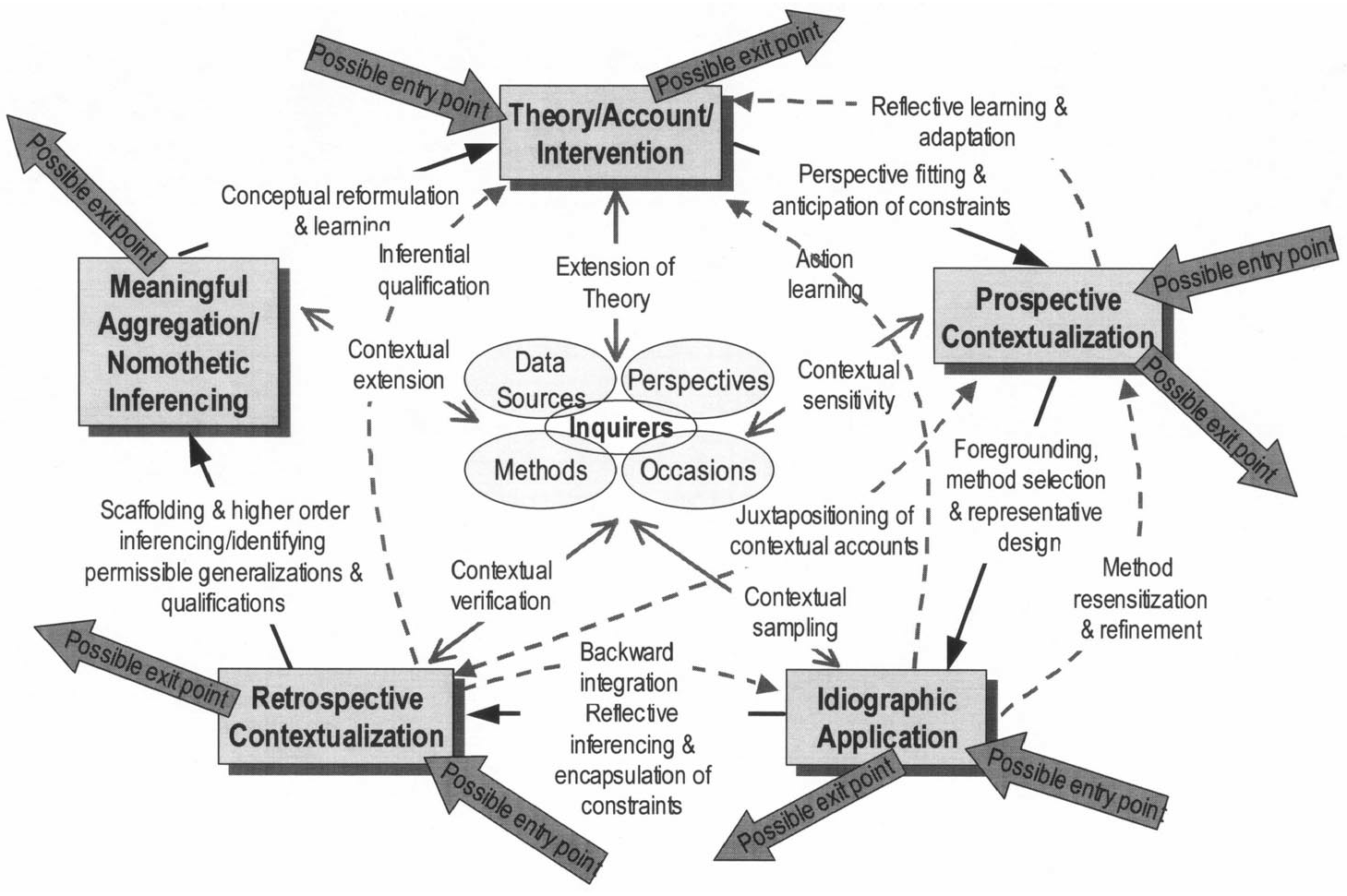
Figure 8. Theoretical-methodological-empirical-practical linkages in organizational complexity science
process. For example, a traditional experiment will often enter the process at the theory stage, whereas an interpretive investigation could enter the process at the point of idiographic application or prospective contextualization. A management consulting event would likely enter the process at the point of prospective contextualization, and either exit at the point of retrospective contextualization or move directly to the intervention stage. A text analytic or content analytic study could commence at the retrospective contextualization level.
The center of the map highlights the evolving dynamics within the inquiry context—it is here where multifaceted triangulation in methods and perspectives can be seen to emerge. There are many cross-process linkages indicated, which describe many of the nonlinear leaps and insights that occur as inquiry or knowledge application, even of the most highly controlled variety, unfolds in time and space. Active practical application and evaluation of behavioral knowledge, reflected in paradigms such as action research or critical theory, are captured through reflective learning linkages, juxtapositioning of contextual accounts, and contextual reformulation.
Table 2 presents an armory of methods and analytical tools that can be brought to bear in complexity science inquiry. This armory is by no means exhaustive, and creative methods and tools for analyzing quantitative and qualitative data, especially using computerized support systems, are continually emerging. The armory is presented here as a reminder that complexity science demands that its workers sample from the broadest possible range of available methods and tools, rather than continually relying on a reduced subset. Quantitative and qualitative data are both of value in complexity science and can be balanced as particular needs and perspectives emerge. Automatic dismissal of the value of one form or the other is counterproductive to achieving behavioral understanding at an appropriate level of complexity and contextual sensitivity.
MORE GENERAL IMPLICATIONS OF THE COMPLEXITY SCIENCE TAPESTRY
Complexity science offers us the first real opportunity to realize an adaptive behavioral science that can free itself from the restrictive bonds of Kuhnian “normal science.” The spinoff effects of this may be far-reaching in terms of how we move people toward modes of cognition, learning, and action better suited to complexity science: we will have to educate people differently, conduct research differently, intervene in social and organizational processes differently, and make our judgments differently. Our old, comfortable paradigms have served us well to help us negotiate predominantly linear pathways through the “mess” toward simple solutions and understandings. Yet these paradigms, in isolation, have outlived their adaptive value, not least because the simple solutions and understandings they yielded lacked richness, robustness, and meaningfulness in the face of dynamic contextual changes, and they did not possess the conceptual “hardware” necessary to surmount these limitations. There are no easy answers or simple solutions, because complexity science, by design, does not pretend to offer them. Instead, it offers diverse avenues for discovering what may end up being a multiplicity of answers that are differentially sensitive to and grounded in specific circumstances, conditions, people, times, and places. Therein lies the real promise of the complexity science tapestry.
Table 2. Methods and analytical tools
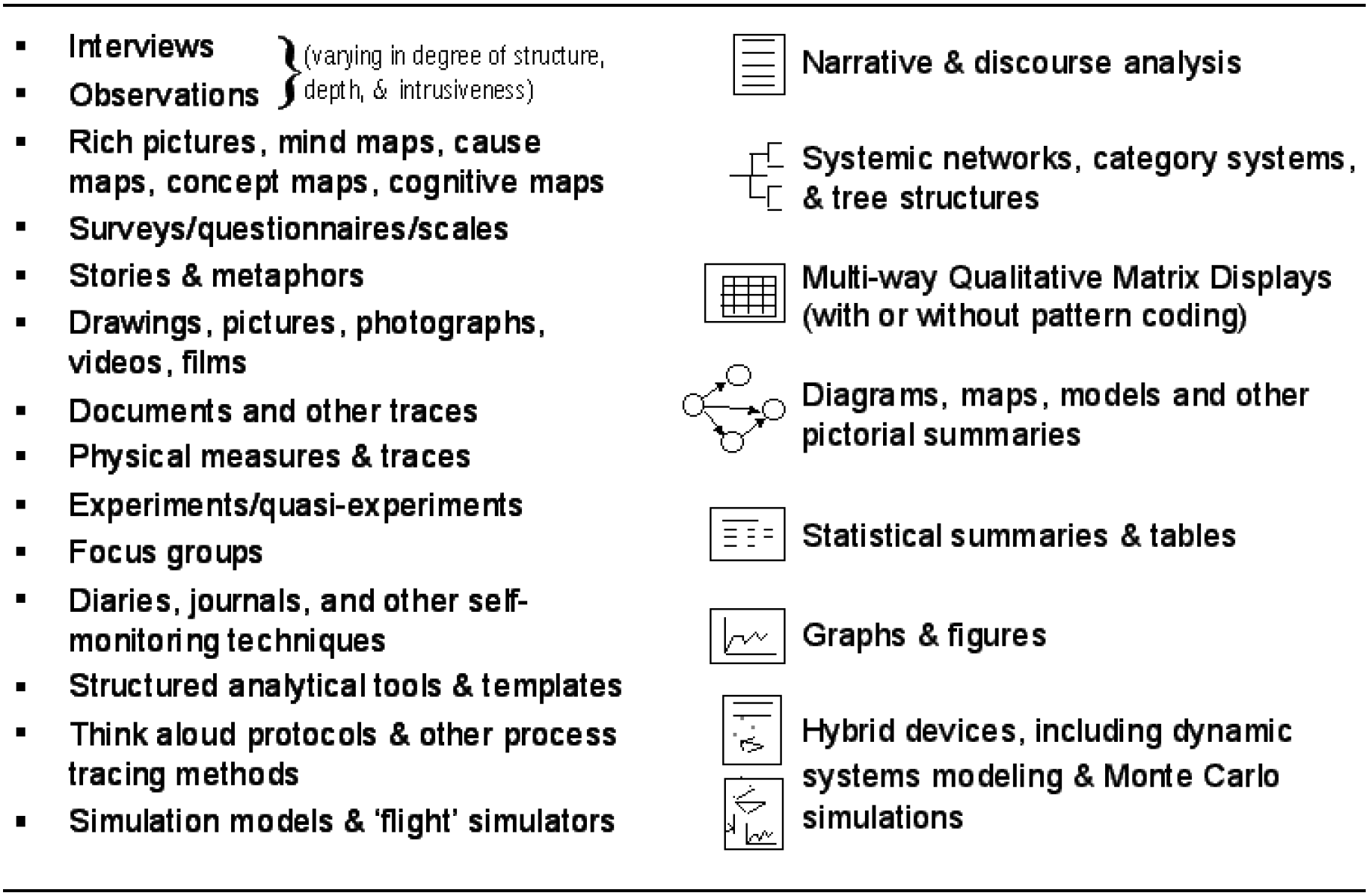
REFERENCES
Abraham, F. D. & Gilgen, A. R. (1995) Chaos Theory in Psychology, Westport, CN: Greenwood Press.
Abrahamson, E. (1996) “Management fashion,” Academy of Management Review, 21: 254-85.
Anderson, V. & Johnson, L. (1997) Systems Thinking Basics: From Concepts to Causal Loops,
Cambridge, MA: Pegasus Communications. Argyris, C. (1990) Overcoming Organizational Defenses: Facilitating Organizational Learning, Needham Heights, MA: Allyn & Bacon.
Argyris, C. (1999) On Organizational Learning, Boston, MA: Blackwell Business.
Ayer, S. (1997) “The application of chaos theory to psychology,” Theory and Psychology, 7: 373-98.
Barton, S. (1994) “Chaos, self-organization, and psychology,” American Psychologist, 49: 4-14.
Beer, F. A. (1993) “Validities: A political science perspective,” Social Epistemology, 7: 85-105.
Bernstein, R. J. (1978) The Restructuring of Social and Political Theory, Philadelphia: University of Pennsylvania Press.
Bertalanffy, L. von (1955) “General systems theory,” Main Currents in Modern Thought, 71: 75-83.
Bertalanffy, L. von (1968) General Systems Theory, New York: Braziller.
Briggs, J. & Peat, F. D. (1999) Seven Life Lessons of Chaos: Timeless Wisdom from the Science of Change, St. Leonard's, Australia: Allen & Unwin.
Brunswik, E. (1952) The Conceptual Framework of Psychology, Chicago: University of Chicago Press.
Burrell, G. & Morgan, G. (1979) Sociological Paradigms and Organizational Analysis, London: Heinemann.
Capra, F. (1996) The Web of Life: A New Synthesis of Mind and Matter, London: HarperCollins.
Casti, J. L. (1997) Would-be Worlds: How Simulation is Changing the Frontiers of Science, New York: John Wiley & Sons.
Checkland, P (1981) Systems Thinking, Systems Practice, Chichester, UK: Wiley.
Churchman, C. W. (1968) The Systems Approach, New York: Dell Books.
Churchman, C. W. (1971) The Design of Inquiring Systems: Basic Concepts of Systems and Organizations, New York: Basic Books.
Cohen, J. & Stewart, I. (1994) The Collapse of Chaos: Discovering Simplicity in a Complex World, New York: Penguin.
Cooksey, R. W. (2000) “Mapping the texture of managerial decision making: A complex dynamic decision perspective,” Emergence, 2(1): 102-22.
Cooksey, R. W. & Gates, G. R. (1995) “HRM: A management science in need of discipline,” Asia Pacific Journal of Human Resources, 33: 15-38.
Cooksey, R. W., Gates, G. R., & Pollock, H. (1998), “'Unsafe' business acts and outcomes: A management lexicon,” Business Horizons, 41(3): 41-9.
Crotty, M. (1998) The Foundations of Social Research: Meaning and Perspective in the Research Process, St. Leonard's, Australia: Allen & Unwin.
Dreilinger, C. (1994) “Why management fads fizzle,” Business Horizons, 37: 11-15.
Dijkum, C. van (1997) “Chapter 7: From cybernetics to the science of complexity,” Kybernetes, 26: 725-37.
Emery, F E. & Trist, E. L. (1965) “The causal texture of organizational environments,” Human Relations, 18: 21-32.
Flood, R. L. (1999) Rethinking the Fifth Discipline: Learning Within the Unknowable, London: Routledge.
Flood, R. L. & Carson, E. R. (1988) Dealing with Complexity: An Introduction to the Theory and Application of Systems Science, New York: Plenum Press.
Flood, R. L. & Romm, N. R. A. (1996) Diversity Management: Triple Loop Learning, Chichester, UK: Wiley.
Fox, D. & Prilleltensky, I. (eds.). (1997) Critical Psychology: An Introduction, London: Sage.
Fuller, S. (1988) Social Epistemology, Bloomington, IN: Indiana University Press.
Gates, G. R. & Cooksey, R. W. (1998) “Learning to manage and managing to learn,” Journal of Workplace Learning, 10: 5-14.
Gregersen, H. & Sailor, L. (1993) “Chaos theory and its implications for social science research,” Human Relations, 46: 777-802.
Guastello, S. (1995) Chaos, Catastrophe, and Human Affairs: Applications of Nonlinear Dynamics to Work, Organizations, and Social Evolution, Mahwah, NJ: Lawrence Erlbaum Associates.
Guba, E. G. & Lincoln, Y. S. (1989) Fourth Generation Evaluation, Newbury Park, CA: Sage.
Guba, E. G. & Lincoln, Y. S. (1998) “Competing paradigms in qualitative research,” in N. Denzin & Y. Lincoln (eds), The Landscape of Qualitative Research, Thousand Oaks, CA: Sage: 195-220.
Harrington, H. J., Carr, J. J., & Reid, R. P (1999) “What is this 'systems' stuff anyway?”, TQM Magazine, 11: 54-7.
Kaplan, M. L. & Kaplan, N. R. (1991) “The self-organization of human psychological functioning,” Behavioral Science, 36: 161-78.
Kosko, B. (1993) Fuzzy Thinking: The New Science of Fuzzy Logic, London: HarperCollins.
Kuhn, T. S. (1970) The Structure of Scientific Revolutions, 2nd edn, Chicago: University of Chicago Press.
Levin, K. (1951) Field Theory in Social Science, New York: Harper.
Levine, R. L. & Fitzgerald, H. E. (1992) Analysis of Dynamic Psychological Systems: Basic Approaches to General Systems, Dynamic Systems, and Cybernetics (Vol 1), New York: Plenum Press.
Lissack, M. R. (1997) “Of chaos and complexity: Managerial insights from a new science,” Management Decision, 35: 205-18.
Lissack, M. R. (1999) “Complexity: The science, its vocabulary, and its relation to organizations,” Emergence, 1(1): 110-26.
Loye, D. (1995) “How predictable is the future? The conflict between traditional chaos theory and the psychology of prediction, and the challenge for chaos psychology,” in R. Robertson & A. Combs (eds), Chaos Theory in Psychology and the Life Sciences, Mahwah, NJ: Lawrence Erlbaum Associates: 345-58.
Loye, D. & Eisler, R. (1987) “Chaos and transformation: Implications of non-equilibrium theory for social science and society,” Behavioral Science, 32: 53-66.
Magala, S. (2000) “Critical complexities (from marginal paradigms to learning networks),” Journal of Organizational Change Management, 13: 312-33.
Maguire, S. & McKelvey, B. (1999) “Complexity and management: Moving from fad to firm foundations,” Emergence, 1(1): 5-49.
Maruyama, M. (1992) “Interrelations among science, politics, aesthetics, business management, and economics,” in M. Maruyama (ed.), Context and Complexity: Cultivating Contextual Understanding, New York: Springer-Verlag: 1-34.
McKelvey, B. (1999) “Complexity theory in organization science: Seizing the promise or becoming a fad,” Emergence, 1(1): 5-32.
McKelvey, B., Mintzberg, H., Petzinger, T., Prusak, L., Senge, P, & Shultz, R. (1999) “The gurus speak: Complexity and organizations,” Emergence, 1(1): 73-91.
Mendenhall, M. E., Macomber, J. H., & Cutright, M. (2000) “Mary Parker Follett: Prophet of chaos and complexity,” Journal of Management History, 6: 191-204.
Miller, J. G. (1973) “Living systems,” Quarterly Review of Biology, 3: 63-276.
Miller, J. L. & Miller, J. G. (1993) “Greater than the sum of its parts: II: Matter-energy processing subsystems,” Behavioral Science, 38: 1-9.
Morin, E. (1992) “The concept of system and the paradigm of complexity,” in M. Maruyama (ed.), Context and Complexity: Cultivating Contextual Understanding, New York: Springer-Verlag: 125-38.
Muller-Merbach, H. (1994) “A system of systems approaches,” Interfaces, 24: 16-25.
Neuman, W. L. (2000) Social Research Methods: Qualitative and Quantitative Approaches, 4th edn, Boston: Allyn & Bacon.
Parker, D. & Stacey, R. D. (1995) Chaos, Management, and Economics: The Implications of Non-linear Thinking, St. Leonards, Australia: Centre for Independent Studies.
Priesmeyer, H. R. (1992) Organizations and Chaos: Defining the Methods of Nonlinear Management, Westport, CN: Quorum Books.
Robertson, R. & Combs, A. (1995) Chaos Theory in Psychology and the Life Sciences, Mahwah, NJ: Lawrence Erlbaum Associates.
Senge, P. M. (1990) The Fifth Discipline: The Art and Practice of the Learning Organization, New York: Doubleday.
Senge, P M., Kleiner, A., Roberts, C., Ross, R. B., & Smith, B. J. (1994) The Fifth Discipline Fieldbook: Strategies and Tools for Building a Learning Organization, London: Nicholas Brealey.
Shapiro, E. C. (1995) Fad Surfing in the Boardroom: Reclaiming the Courage to Manage in the Age of Instant Answers, Sydney: HarperCollins.
Sharlett, J. (2000) “A philosopher's call to end all paradigms,” Chronicle of Higher Education, Sept. 15: A18-A20.
Skyttner, L. (1997) “General living systems theory: A basis of dynamic simulation,” Kybernetes, 26: 885-92.
Smith, H. W. (1975) Strategies of Social Research: The Methodological Imagination, London: Prentice Hall.
Somit, A. (1992) “Crossing intellectual boundaries: Biology and politics, problems and issues,” in M. Maruyama (ed.), Context and Complexity: Cultivating Contextual Understanding, New York: Springer-Verlag: 109-24.
Spell, C. (1999) “Where do management fashions come from, and how long do they stay?”, Journal of Management History, 5: 334-8.
Tetenbaum, T. J. (1998) “Shifting paradigms: Newton to chaos,” Organizational Dynamics, 26: 21-32.
Tweney, R. D. (1994) “On the social psychology of science,” in W. R. Shadish & S. Fuller (eds), The Social Psychology of Science, New York: Guilford Press: 352-63.
Tweney, R. D. & Chitwood, S. T. (1995) “Scientific reasoning,” in S. E. Newstead & J. St. B. T. Evans (eds), Perspectives on Thinking and Reasoning: Essays in Honour of Peter Wason, Hove, UK: Lawrence Erlbaum Associates: 241-60.
Waldrop, M. M. (1992) Complexity: The Emerging Science at the Edge of Order and Chaos, London: Viking.
Wicklund, R. A. (1999) “Multiple perspectives in person perception and theorizing,” Theory and Psychology, 9: 667-78.
Wilkinson, S. (1997) “Feminist psychology,” in D. Fox & I. Prilleltensky (eds), Critical Psychology: An Introduction, London: Sage: 247-64.
Yolles, M. (1998) “A cybernetic exploration of methodological complementarism,” Kybernetes, 27: 527-42.